Sony A80K Reviewed at $1,599.00 (55")
Product Name: Sony A80K
Product Description: 2022 4K OLED TV
-
Design - 9/10
9/10
-
Video Quality - 8.9/10
8.9/10
-
Ports & Connectivity - 9/10
9/10
-
OS, Apps and Features - 9.3/10
9.3/10
-
Price / Quality - 9/10
9/10
Summary
Reviewed at $1,599.00 (55″)
Pros
- Amazing black levels
- Excellent colors
- Many online and streaming features
- Good price
Cons
- Lower peak brightness than last year
- Only 2 HDMI 2.1 ports
- OLED still has higher burn-in risk
- Average sound
Cheapest Places to Buy :
*We are a reader-supported website. When you buy through links on our site, we may earn a small affiliate commission at no extra cost to you. Home Media Entertainment does not accept money for reviews.*
Sony, along with Samsung, may be the first out of the gate with a new QD-OLED TV in 2022 but for Sony OLED remains as important as ever. And this is obvious as this year they decided to expand their OLED lineup with three models available compared to last year’s two. And so in our Sony A80K review we are going to be testing the second in line OLED available and how it compares to the big boys across the competition.

The A80K is supposed to be a direct successor to the 2021 A80J and while last year this was supposed to be the more affordable OLED available, with the release of the A75K this year it seems that Sony has decided to mix things a bit more. In terms of specs the A80K looks awfully similar to the A80J so it will be interesting to see if the two TVs actually perform the same.
A quick look at the specs does not reveal any obvious differences between the two releases as the Sony A80K uses a 100/120Hz OLED panel, comes with Cognitive Processor XR and Sony’s most advanced Acoustic Surface Audio+ system. There is Dolby Atmos, DTS and Dolby Vision support, two HDMI 2.1 ports with VRR out of the box, and is packed with the latest Google TV platform including plenty of extras like Chromecast, Airplay 2 and Homekit, Bravia Core, voice control, Netflix calibrated mode, IMAX Enhanced, Calman Ready and Bravia Cam support.
From just the above the Sony A80K seems more like a re-release than actually a new model. Does the new A80K performs any different from its predecessor or we get more of the same in 2022. Keep reading our analysis to find out.
Design
The A80K, being an OLED, is an extremely thin TV overall but paying a close look at it we can say that it is not the same as last year’s A80J but rather is using a new, slightly altered design.
One thing that made an impression was that while most OLED TVs from all manufacturers use an extremely thin panel along with the plastic box that houses all electronics at the back of it, the A80K actually has a slightly curvy panel at the back that we usually see in LED LCD TVs. It is still very thin, much more than any non OLED TV we have tested but why Sony went for such a design is a bit of a mystery.
Overall what we have here is a nicely built TV that has this premium feel to it although most of it is made of plastic as usual. Thickness was measured at about 2.1″ (5.4 cm) which is just about the same as the A80J was.
The back of the TV is also different, the grid style design is preserved but gone are the diagonal grooves while the ports layout has also changed with all of them now being placed sideways on the right side. The power connector is still isolated on the left side while the VESA mounting holes are the only other element visible. Gone is also the XR logo that was engraved in the middle of the A80J.
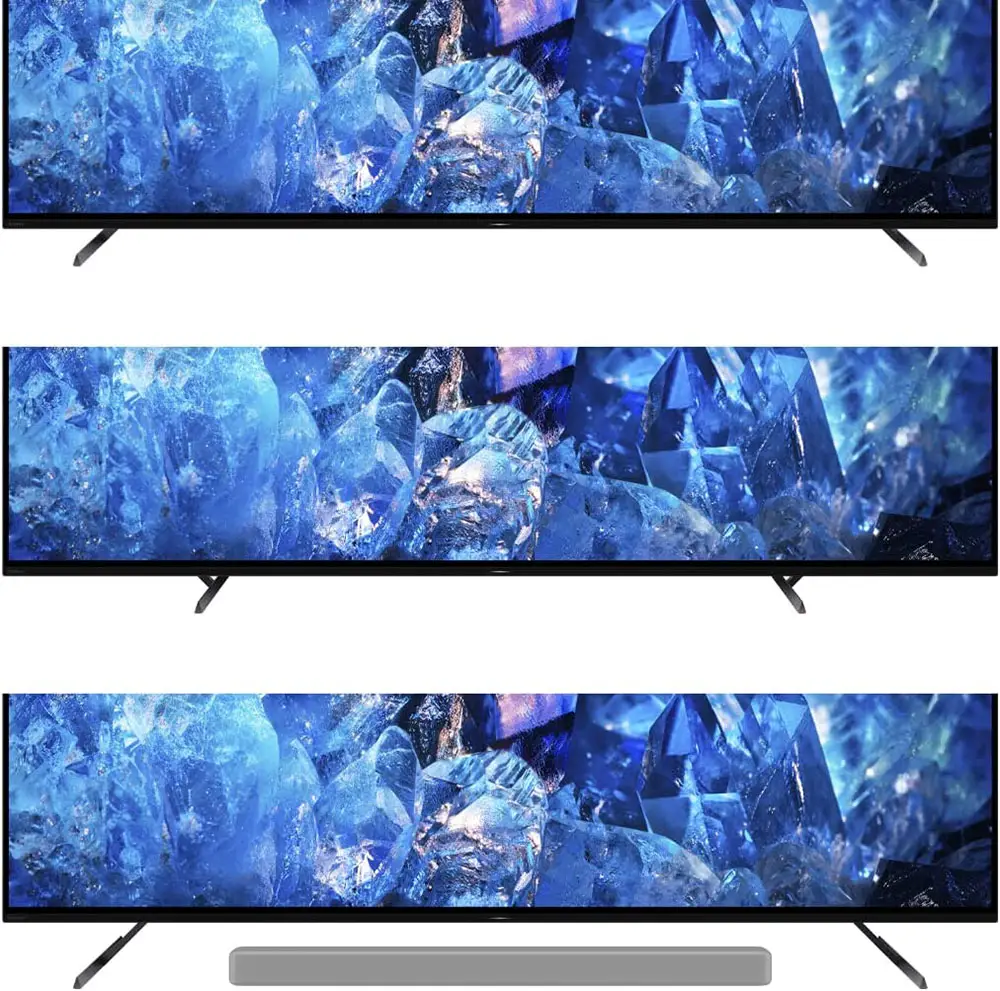
The design of its stand follows the fairly standard bench type that offers the TV more stability but on the other hand you need a bigger furniture if you plan on placing it on one instead of the wall. The TV was fairly stable with the stand provided and there was little wobble overall.
What is different is only the look as the one on the A80K use a triangle design instead of a squarish one on the A80J. The stand also retains the same ability to change its position depending on your needs. There are three placements available, wide position, narrow position and soundbar position which really helps in different situations and smaller furniture.
Lastly as far as cable management is concerned nothing changed from the A80J as there is none. No grooves to drive the cables through and no special clips that can be attached to the legs and keep all cables together.
As for the new updated remote, this feels simpler, less cluttered and easier to handle. Design wise the remote of the A80K is no different from all other Sony releases in 2022. The only aesthetic difference is that this comes with a brushed black body while some other premium models use one made of brushed metal. So basically the one in the A80K is exactly the same as all other Sony TVs we have tried this year.

We really liked Sony’s 2021 remote but to be honest it had too many buttons with many of them never to be used. So making the remote smaller and simpler was the right thing to do and we do love what they have come up with. Also keep in mind that some versions of the A80K come with a backlit remote but this doesn’t seem to be the case across all markets so make sure you check on that when buying.
The A80K probably is the first OLED TV that doesn’t look like OLED very much. The back side is covered entirely in plastic and has this curvy look that we usually see in LED LCD models. But it is still a very thin TV and will look great no matter where you place it.
Video Quality
Processor technology used
In terms of image processing the A80K uses Sony’s best Cognitive Processor XR which is the same chip used across most premium and top tier TVs from Sony. As is the case with all new models we don’t know if this is exactly the same chip as it was last year as Sony is secretive about anything that has to do with their chips but judging by its specs and features it seems to be the same.
The Cognitive Processor XR divides the screen into hundreds of zones and recognizes individual objects in these zones better than ever before. What’s more, it can cross-analyze around a few hundred thousand different elements that make up a picture in a second like focal points, contrast, colors, motion and clarity and determine ways in order to improve the end result even more.

In this part of our review we use a series of videos in different resolutions in order to determine how good the up-scaling capabilities of the TV are. Content resolution and quality varies from low quality broadcasting material, 480p, 720p and 1080p content. The A80K had no problem whatsoever to up-scale everything to 4K. We didn’t notice any bothering artifacts or any other problems during the process. True flagship performance here.
But the new processor is not only good at providing excellent picture quality as it has also a few interesting audio features. Being included in the XR Sound suite the processor supports XR Sound Position in order for the audio to match exactly what is displayed on screen through the included Acoustic Surface Audio+ system while XR Surround is responsible in creating a virtual 3D environment in order to up the immersion even more.
Also with the new Bravia Cam the built-in Ambient Optimization Pro can calibrate the audio no matter your viewing position. But more on the audio in the appropriate section.
In terms of processing the A80K is in line with the rest of the Sony TVs that use the same Cognitive Processor XR.
Lighting technology used
With the release of Sony’s new A95K QD-OLED things became a bit more complicated in terms of what technologies each of their simple OLEDs are using. The A80K seems to go for a WRGB panel without the addition of a heatsink like we saw in 2021’s A90J. In essence the A80K seems to come with a similar configuration as the A80J with the only difference between them being that the A80K is using a new improved OLED panel that in theory allows greater brightness output.
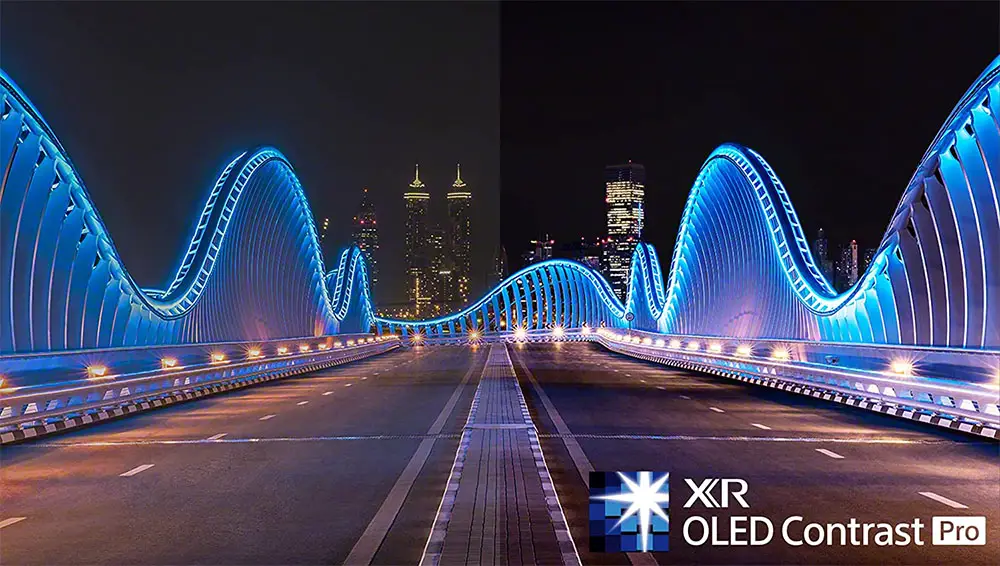
The benefits of OLED technology are well known and it results in higher light control and precision, and the ability to turn off completely its pixels means that you can get totally black levels which is really as good as it gets and really elevates the image quality tenfold compared to what we see in most LED LCD panels.
Because there is no backlight the A80K has no problems like blooming that creates bright halos around bright objects when seen in dark backgrounds and also its image quality is not dependent on how many zones the backlight has as all FALD and mini LED LCD TVs do. So in this regard all OLED panels behave the same.
But as with everything, OLED has a few shortcomings. The first one is that all OLED TVs, due to the technology involved, cannot be as bright as LCD TVs can and this is the reason why QD-OLED was invented. In the early years there were small advancements in this but the last few yearly releases seem to have reached their full potential.
And the second shortcoming is that OLED technology is more prone to permanent burn-in. We have seen manufacturers adding special features to combat this but nevertheless OLED has slightly increased risk of burn-in due to the use of organic materials and should be handled with care. But the reality is that the last couple of years OLED TVs have become very burn-in proof with all the safeties that manufacturers have added into them.
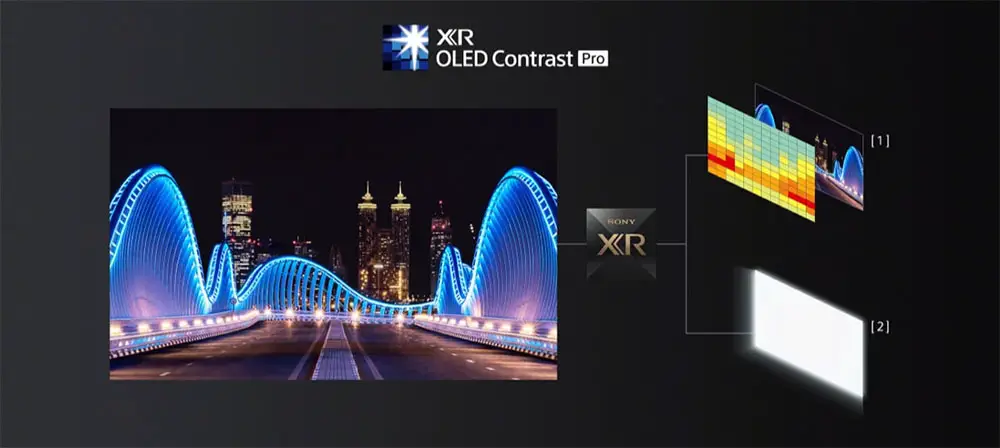
In our blooming test patterns the A80K did perfect as you should expect from an OLED TV. Being able to see a bright object in a completely dark background and don’t have any blooming on sight is a real treat and shows the strength of OLED even after so many years in the market. Nothing more can be said here. If blooming is your number one problem OLED is your only way to go and the A80K does perfect in this regard.
Brightness / Contrast
Onto our brightness tests now and it will be interesting to see if the TV will do any different from its predecessor.
For this test we used the Custom mode, which tends to be the most accurate one in many Sony TVs, Expert 1 color tone and Brightness set to max. In our SDR brightness test over a 10% white window we got 467 nits, which is good enough for SDR content but nothing spectacular to talk about. On our HDR brightness test we switched to Expert 2 color tone and over a 10% white window we got 682 nits of brightness which again is ok but not as good as we were hoping for.
Unfortunately these numbers indicate that the A80K performs lower than the 2021 A80J. It seems that there is about a 10% lower overall brightness output which is disappointing considering the improved panel used in the A80K.
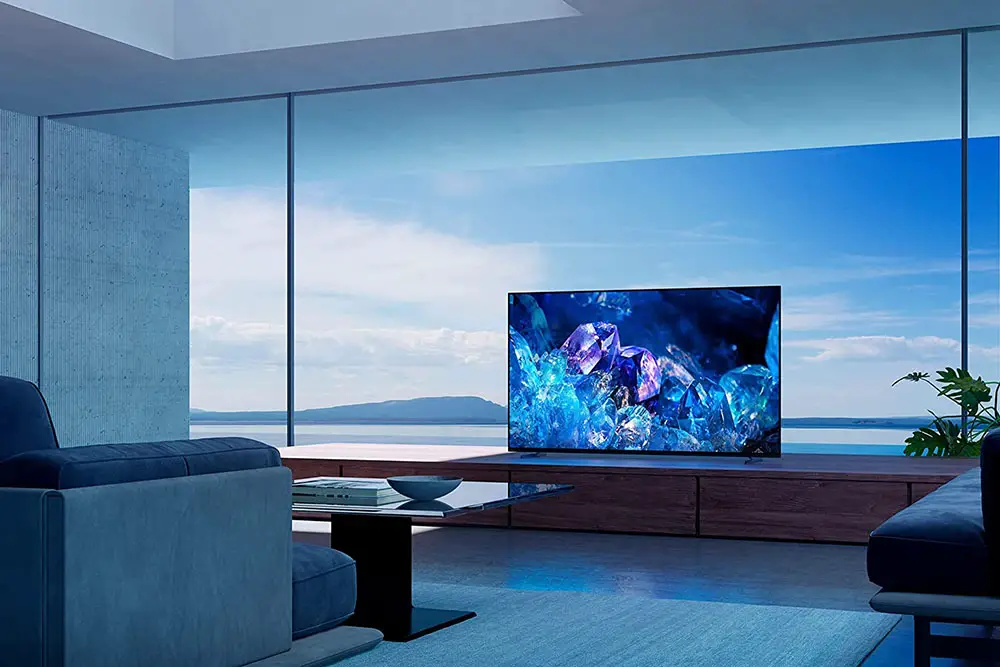
Brightness levels followed the EOTF reference values very close up to its relatively sharp roll-off point which means that some details may be lost. Just keep in mind that in order for the TV to follow the curve accurately you have to use its Gradation Preferred tone mapping as the other options are far less accurate.
As for contrast having an OLED panel means that the A80K can switch off it’s pixels entirely meaning it gains almost infinite contrast ratio resulting in true deep blacks compared to greyish blacks we see in many LCD models while it’s panel uniformity was also extremely good.
One thing we should mention is about permanent image retention which is a hot topic among OLED fans. For this we recommend to turn on Pixel Shift from the TV settings and run Panel Refresh as frequently as Sony suggests. Also keep in mind that long gaming or broadcasting sessions can make certain logos or static graphics to burn-in but since this is not a certain thing you should always change the image every few hours just to be on the safe side.
Viewing angles
Viewing angles was always one of the strongest points of any OLED and as such the A80K could not be any different. OLED is the best technology in this regard and no matter what kind of advancements they have done, LED LCD technology will never get so good as this.
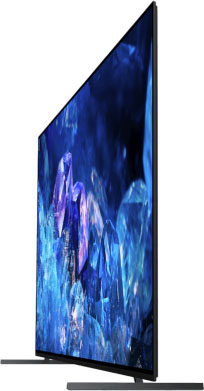
In terms of performance the A80K behaved similar to all other OLED equipped TVs we had previously seen no matter the brand. This means that even at angles that reach about 45-50 degrees colors, black levels, brightness and contrast seem to hold up really well with no major degradation. Obviously anything more and the image quality deteriorates fast but no one would be watching at such extreme angles anyway.
If you want to use this TV as a family TV with many members watching at different angles then the A80K is ideal for that kind of use.
HDR support
As far as HDR protocols Sony likes to include the same across the entire lineup, either it is top tier or lower end TV. So here things are pretty much the same as the rest of the 2022 offerings.
In total the A80K features the standard trio of HDR protocols that include the basic HDR10 which is required for 4K UHD playback, HLG that is used in broadcasting and lastly the more advanced Dolby Vision that uses dynamic metadata and offers the best quality from the three available.
If you don’t care about HDR10+ then you shouldn’t really worry about it. Dolby Vision has far more support although HDR10+ seems to be getting some traction both from online streaming services like Amazon Prime and in the UHD format.
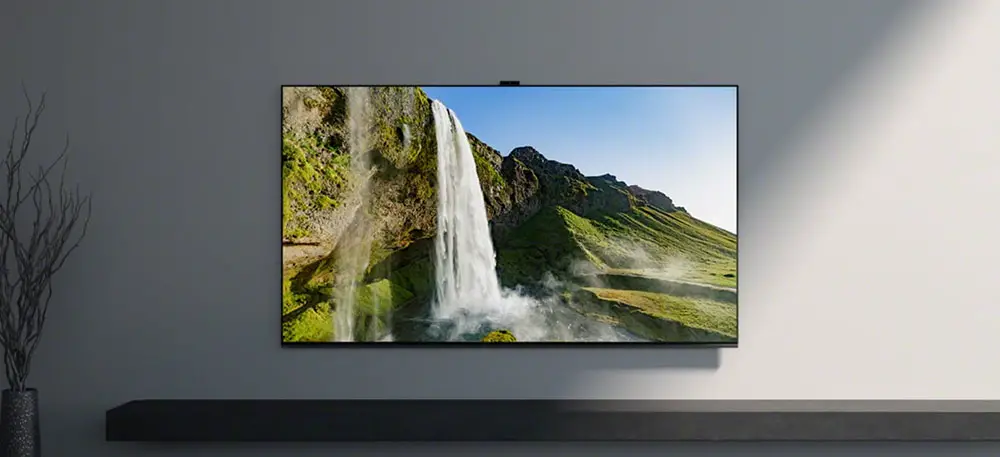
If you really want to have both HDR10+ and Dolby Vision then you will have to look at some other brand like Hisense or depending where you live to Panasonic or even Philips as none of the big three (LG, Samsung and Sony) support all of them.
Our opinion remains that this is a pointless conflict and all manufacturers should embrace all HDR formats instead of pushing consumers to choose by brand because of this.
Color coverage
The A80K, as with some other premium Sony TVs, is equipped with certain tech in order to allow it to display deeper and more lifelike colors. As such Sony has used an XR Triluminos Pro display in combination with XR Color technology which is included in their XR Picture suite. This is the same tech that is included in all premium TVs that come with the Cognitive Processor XR and the XR Picture suite.
According to our measurements the TV has about 99% coverage of the DCI-P3 color space which is almost perfect. On the wider REC.2020 color space we got a coverage of 75% which is still very good and results in very lifelike and accurate colors.
The numbers above are a bit better than what we had measured in the A80J but the difference is small and you will be hard to distinguish any differences with naked eyes so we can call them equal here. Keep in mind that we took these measurements with the Gradation Preferred tone mapping setting.
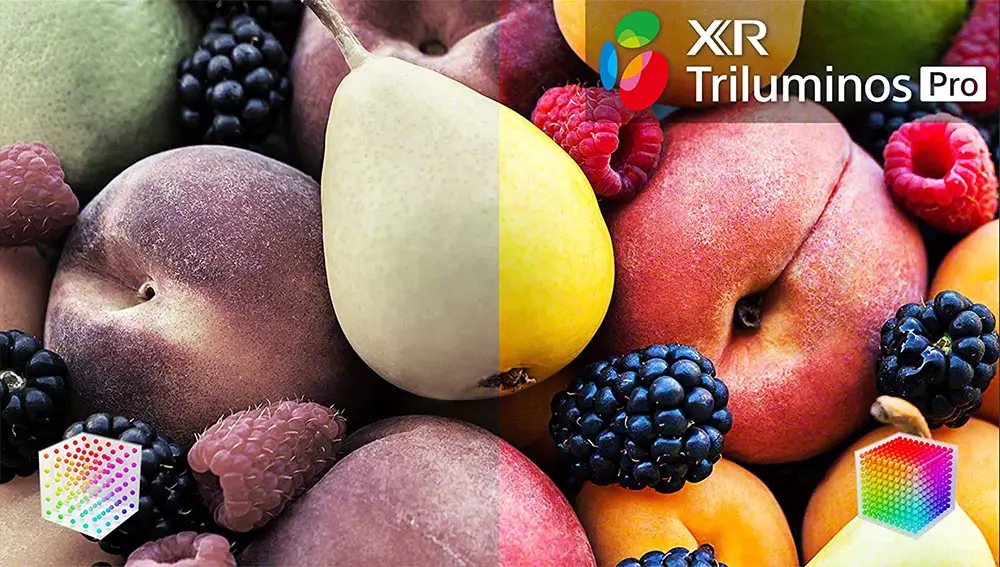
Before calibration the A80K had great color accuracy with very few problems making it a great TV if you are a person that doesn’t like to go deep with calibration settings. White balance needed some adjustment but most colors had values below the DeltaE limit of three. But both of them can be further corrected after calibration making the final image quality even better than with out of the box settings.
Color gradients were extremely good with very minor banding in some darker colors. There is also a Smooth Gradation feature in case banding is bothering you but you are going to loose some fine detail if enabled as is always the case with this feature.
Motion performance
Next we have our motion performance tests and from everything we saw during our time with the TV there are not a lot of differences between the A80K and the A80J. The new release uses a 100/120Hz panel along with Sony’s XR OLED Motion which is the company’s motion interpolation feature included in the XR Picture feature set of their Cognitive Processor XR.
You have the option to use either the standard motion interpolation system or use the Black Frame Insertion (BFI) interpolation that is adding black frames in between individual frames and can potentially smooth out motion. BFI can be enabled by turning Clearness to max if you use the Custom setting in the MotionFlow menu. Unfortunately BFI works only with 60fps content so you cannot use it for 4K@120Hz gaming.

Overall motion behavior was excellent as there was almost no blur visible but we did notice some stutter which is not something unusual with OLED panels. With fast action scenes and camera pans the TV’s motion interpolation worked very good and it was a step beyond some other models we had tested recently. Obviously some artifacts still appeared but they were not so obvious or bothering to be a big problem.
From the test material we tried on the A80K we can say that compared to last year there is no change whatsoever. Both TVs have solid performance and good motion interpolation features. Minor artifacts appear with fast camera moves but overall we get a very cinematic feel from what the A80K was capable of.
Input lag
Onto our input lag tests next and here we are expecting to see good values overall. After all most TVs nowadays, no matter their price range, are doing exceptionally good in this part.
According to our measurements the A80K measured an average of 17.8ms input lag in both 1080p and 4K resolutions at 60Hz with the use of Game mode. At 120Hz we measured 9.5ms in both 1080p and 4K resolutions which is amazing and low enough for all kinds of gamers either it be casual or hardcore ones.
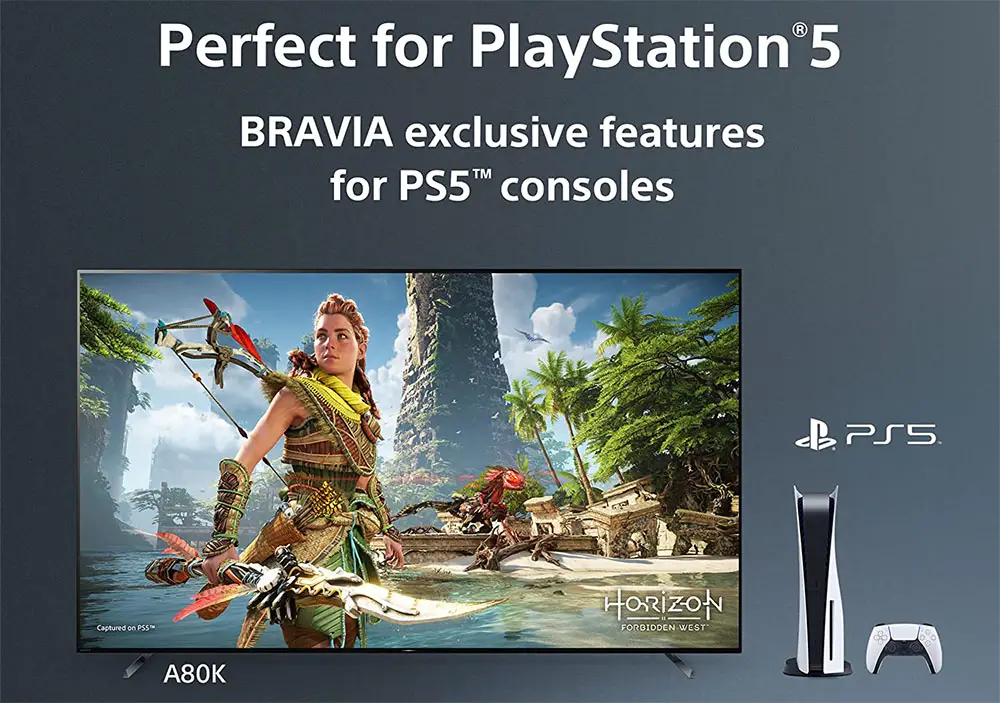
These numbers are great and very close to what the A80J could do, even if slightly worse. But in general they are slightly higher than what LG and Samsung offer in their TVs. But even as such with such low figures, gaming can really be a pleasure, just make sure you use the available Game mode as outside that the input lag will greatly increase to around 155ms which can still can be fine for slow paced games but for nothing more.
We should also not forget to mention that the TV supports Auto Low Latency Mode (ALLM) that can be used with any devices that support that like the PS5 and Xbox consoles and can greatly benefit users. As with all Sony TVs there is no HGiG mode but we do get Auto Genre Picture Mode and Auto HDR Tone Mapping which are Playstation 5 specific features.
Thankfully, this year the A80K comes with VRR support out of the box unlike the A80J that we had to wait for an update. HDMI Forum VRR and G-Sync are supported but unfortunately not FreeSync. Sony is not supporting that in any of its releases so don’t except that anytime soon.
For testing the A80K’s capabilities we connected our PS5 and tried the games Astro’s Playground and Call of Duty: Vanguard which come with VRR support. As with any premium model we tried before, the A80K offered us an amazing gaming session. We don’t consider ourselves hardcore gamers but from what we saw this can be the perfect gaming TV. Fast response times and no commands delays is what you will get. What more you can ask for?

Image quality impressions
From everything we saw we cannot say that the A80K is better or worse than 2021’s A80J. There are small differences here and there with the A80K performing better with colors while on the other hand the A80J is brighter. But with real world content the differences will be hard to notice unless you have both of them side by side so we can call them equal overall.
As for the A80K specifically, the TV had excellent upscaling capabilities, colors and gradients were amazing, out of the box performance was really good, contrast was breathtaking as any OLED should be, we got excellent viewing angles, solid motion and input lag that any gamer can fall in love with.
Brightness in both SDR and HDR was good but not as good as we were hoping for and surely there are other OLEDs that can go brighter and have more impactful HDR. The TV can go a bit brighter than our measurements but as usual you will have to sacrifice some of its image accuracy for doing so.
Audio Quality
When it comes to sound Sony has developed several technologies that uses in their TVs and the one that is included in the A80K is their most advanced one called Acoustic Surface Audio+. Basically this is the same system that was used in the A80J but it seems that the one in the A80K is a bit more advanced.
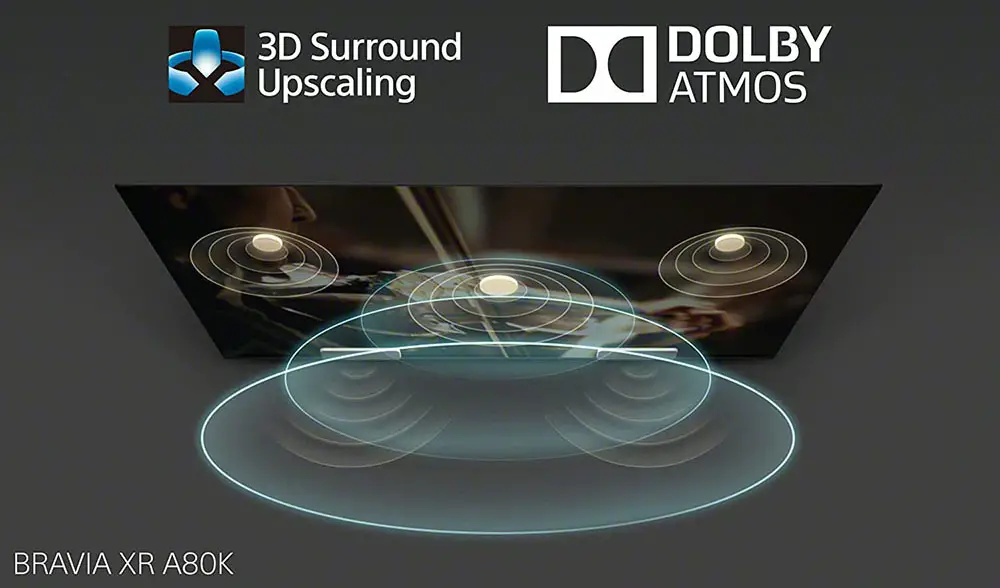
This system basically uses actuators at the back of the panel that vibrate and use the whole panel as a huge membrane and thus create sound. This way it seems like audio is coming from within the screen giving you a better sense of realism.
Last year the A80J was using two actuators and two subwoofers in the same system. The A80K on the other hand ups the number of actuators to three which may not mean a lot but surely will help the TV to output sound more accurately across the panel.
Power output across all actuators and subwoofers is evenly distributed at 10W + 10W + 10W + 10W + 10W.
There is support for Dolby Audio, Dolby Atmos and DTS Digital Surround sound but keep in mind that as good as the A80K’s audio system may be it cannot convey the real sense of positional audio as a true surround system can. The hardware is simply not capable enough for real Atmos and surround action.
Also keep in mind that Sony is one of the few companies that still supports DTS and can even pass-through both Dolby Atmos and DTS:X signals from its eARC port so if this important to you then the Sony is your only choice from the big three (Samsung, LG, Sony).
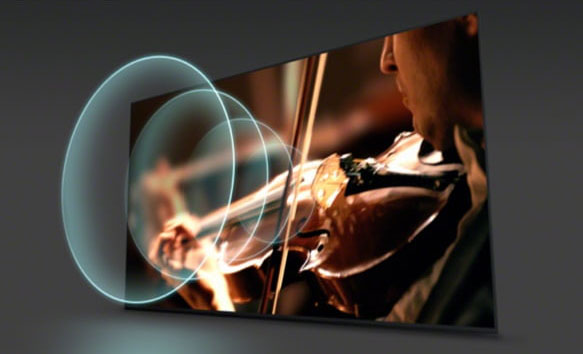
The inclusion of the XR Cognitive Processor has allowed the A80K to include a few more advanced technologies which is the XR Sound suite. This includes the XR Sound position which with the help of the Acoustic Surface Audio+ technology makes sound originate from the exact spot on the screen making audio so much more realistic.
Also with XR Surround the A80K is using 3D surround upscaling in order to create a more immersive virtual surround environment. As with most TVs that include some short of virtual tech the A80K does not offer true surround activity as there are no real rear speakers to begin with. As such the action is entirely front oriented.
Overall we can say that not much have changed from last year in this area. Yes, the audio system of the A80K is slightly better than the one in the A80J but the difference is very small and it is good enough only for casual use. If you want audio that will match the excellent picture quality then a separate soundbar or surround system with Dolby Atmos capabilities is a must.
Before closing this part we should mention that the A80K also features Sony’s Acoustic Auto calibration in order to get the best audio performance no matter your sitting position. This can be used in combination with the new Bravia Cam as it will detect where you sit in the room and calibrate the audio accordingly. This feature will be available after a firmware update and unfortunately we didn’t have the chance to try it out ourselves yet.
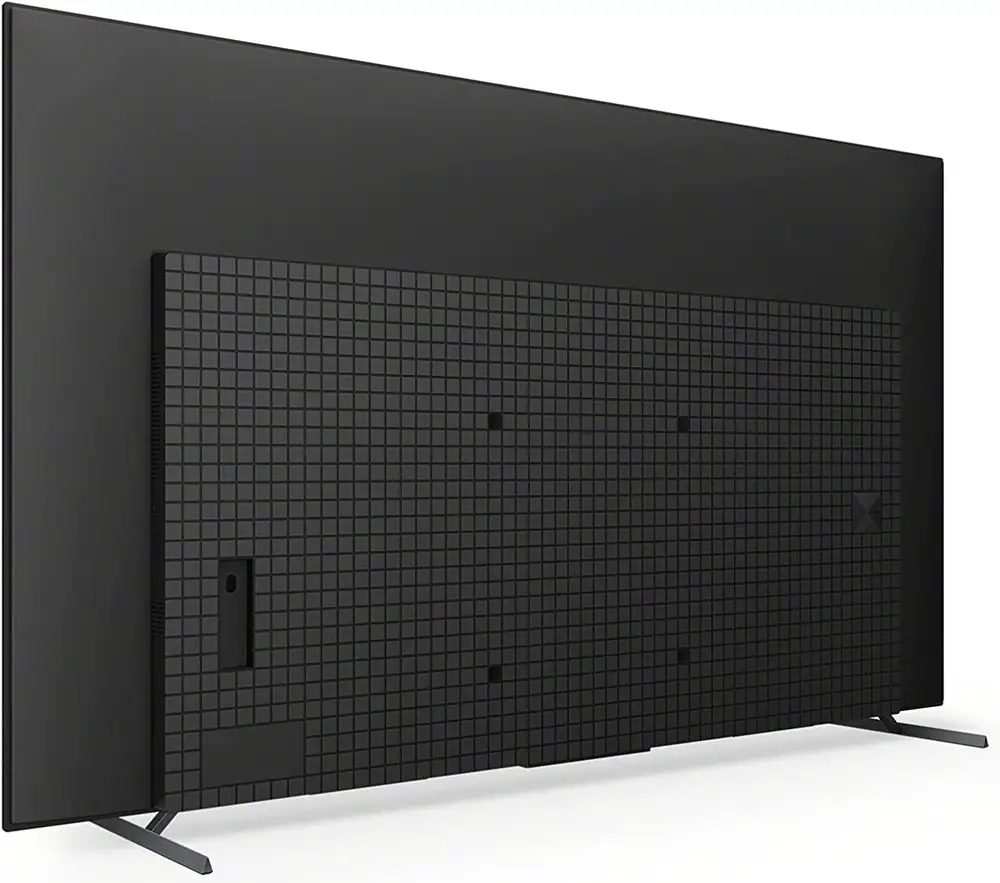
Ports and Connectivity
When it comes to ports layout Sony has been using two different ones with one having all ports looking sideways while the second has separated them with some looking sideways and the rest downwards.
Strangely enough while the A80J was using the second configuration, the 2022 A80K goes for the first with all its ports looking sideways. Basically the layout is exactly the same as the one we saw in the Sony X90K. Why Sony went for this change is not known but this is what it is.
Going from top to bottom we get two USB ports for connecting external storage or powering various devices, a digital optical audio output for connecting older equipment that do not support HDMI connections, a composite video input that also acts as an S-Center speaker input, four HDMI ports for connecting all your devices, an Ethernet port for wired connection to your network, an RS-232C port for control, an IR input and the usual antenna/cable connector.
Sony, unlike some of the other big manufacturers actually provide a USB 3.0 port in most of their TVs, even the most low cost ones. Usually manufacturers don’t seem very fond of using the newer USB ports and rely mostly on the archaic 2.0 version even for many of their top premium models so this is definitely a plus and good for Sony that decided to do the obvious.
Also another thing to mention is that, as with all Sony TVs, we get two HDMI 2.1 ports along with two more older HDMI 2.0 ones. Although some other manufacturers like LG and Samsung offer four HDMI 2.1 ports at least two are better than one.
The problem here is that one of them is also the one with ARC/eARC functionality so if you plan on using that then you are left with a single HDMI 2.1 port. In general all TVs that feature only two ports use Mediatek’s SoC but at least the HDMI 2.1 ports in the A80K provide full bandwidth in order to allow high frame rate gaming and all HDMI 2.1 gaming features.
The HDMI 2.1 ports in the A80K support ARC, eARC, HFR, ALLM and VRR. With VRR you should know that it is supported out of the box, something that applies for all 2022 Sony models, but only HDMI Forum VRR and G-Sync are available. FreeSync VRR is not supported, which again is the standard with Sony TVs and we are not surprised by the lack of it.
One thing that doesn’t seem to have changed is the Ethernet port that for one more year will only support up to 100Mbps which is a real shame but not entirely surprising given the fact that all manufacturers still include 100Mbps adapters in their TVs. We don’t believe that upgrading these ports to Gbit speeds would up the cost so much and with streaming requirements increasing every single year this change should have been made some time ago.
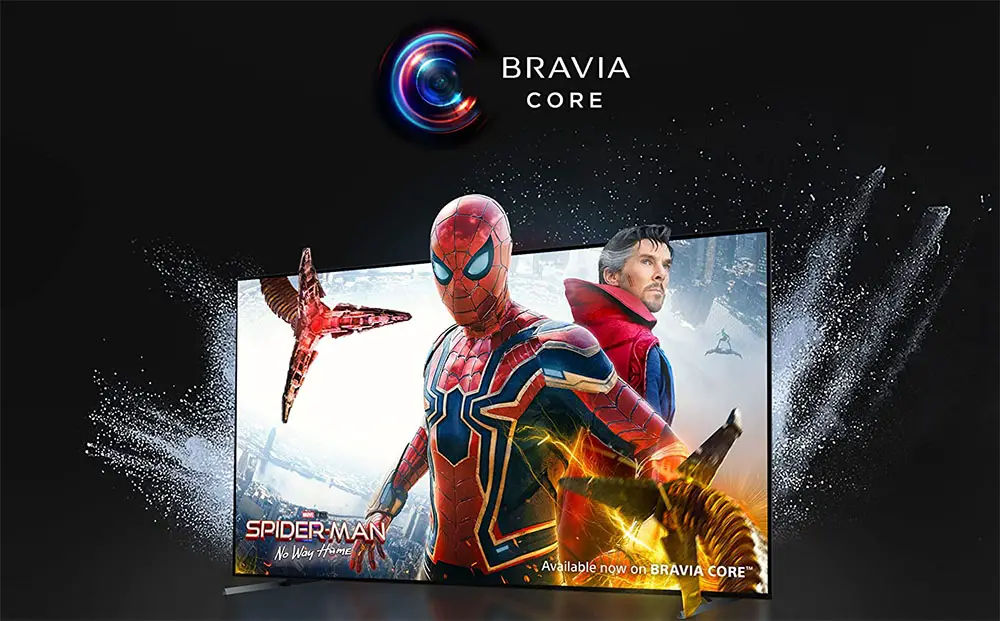
And considering that the A80K comes with Bravia Core we are even more harsh to Sony for not updating their Ethernet adapters. The reason for this, is because in order to access Bravia Core’s highest quality Pure Stream available at 80Mbps you must have a minimum internet speed of 115Mbps. So in essence you cannot do that with a wired connection and have to rely on wireless with all the problems this can bring.
As for its wireless capabilities things are pretty much the same across the board so the A80K comes with built-in WiFi (802.11ac) along with Bluetooth v4.2. Unfortunately no Bluetooth 5 for one more year although in most cases v4.2 should be just fine.
The only difference compared to the A80J seems to be the omission of the headphones jack, something that is common among most manufacturers in 2022.
OS, Apps and Features
The A80K is using the same Google TV platform that Sony is using in all their releases this year and is the same as the one we saw in our other 2022 reviews like the X95K and X90K so our observations here are entirely the same. In our opinion Sony did the right thing to move from Android TV to Google TV as this proved to offer a better overall experience in comparison.
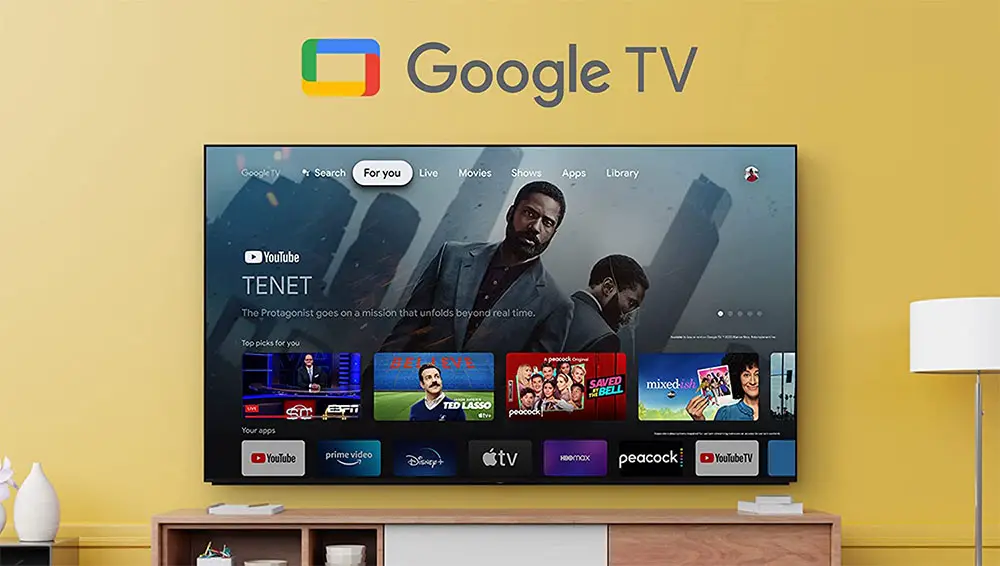
Now many of you may be puzzled what the difference between Android TV and Google TV is. Well, it’s not so much difficult to understand what has changed really. Google TV is still Android TV but with an extra layer on top of it. Think of it like it is in Android smartphones. Most manufacturers that use Android in their releases they use on top of that their own layer that gives this extra something to their UI that make them unique both in appearance and functionality.
The same is with Google TV. You still basically use Android TV but there is the extra Google TV layer on top in order to make the UI feel different both in looks and functionality. It seems that all 2022 Sony TVs come with the same Google TV 10.0 we saw in last year’s models so almost everything is once again the same as what we experienced a year ago.
Google TV seems to have been designed around recommendations, either it be movies, TV shows or applications and this seems to be the main focus of the latest OS in general. During setup the wizard asks you of what specific streaming services you use in order to customize the Home screen recommendations.
Keep in mind that Google TV is still Android at its core even though it looks different. But with Google TV things seem more fluent, more direct and more easy to navigate around.

If there is one thing that Android has in abundance that is huge app support. Through the included Google Play Store you can find literally thousands of apps that you can download and use except from the pre-installed ones. There is so much content available that you will definitely find the ones you are looking for and the list goes on and on.
All the big names are obviously present like Google TV, Disney+, Netflix, Amazon Video, Hulu and Youtube as well as Pandora, Tidal, Google Play Music, Spotify or iHeartRadio. As always some of them are region dependent so make sure the ones you are interested in are working in your area. Lastly many apps like Netflix and Youtube support playback for both 4K and HDR content for those interested in it.
The A80K also comes with the updated Netflix Adaptive Calibrated Mode and what this does is to allow you to experience picture quality close to a filmmaker’s vision and intent for all content that is streamed through the Netflix streaming service.
We say updated because now this feature works together with the ambient light optimization feature of the A80K by optimizing the picture brightness based on your room lighting conditions.

The TV also comes with Bravia Core and this is Sony’s online streaming service that promises high quality streams up to 80 Mbps and additional IMAX Enhanced content. Bravia Core offers some very decent and high quality streams but unfortunately you cannot use a wired connection for their best quality as this needs a 115Mbps connection and the Ethernet port is capped at 100Mbps, thus forcing you to use wireless only.
Chromecast is also available here and it gives you the ability to stream content from other Chromecast enabled devices like mobile phones and tablets directly to the TV. Voice control is also present but it seems that it is a bit limited compared to other competing models. By that we mean that although you can use the remote’s built-in microphone to give commands to Google Assistant, for Amazon Alexa you will need an external Alexa enabled device to work. Additionally there is also Sony’s Voice Search available.
We have seen the same thing in many other Sony TVs and probably this has to do with the fact that it’s using Google’s Android system and thus having Alexa built-in was not possible. With voice control you can issue various commands to the TV but functionality extends far beyond that as you can control any smart devices you have in your house also.
There is also a built-in media player available that you can use to playback various video and audio content from an external storage connected to the USB ports. Support is pretty good for a built-in player and compared to previous years we can admit that it will be able to play more files in comparison but in general don’t expect it to replace your dedicated media player box if you use one. If there is a file that is not following the usual standards it will not play it, something that a dedicated player might will.
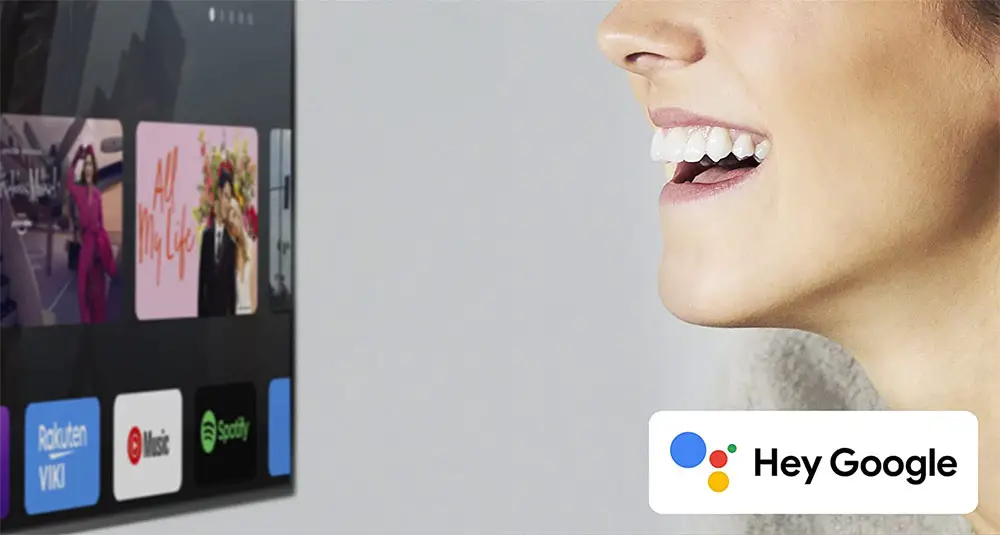
As always we tested the built-in media player with an array of files we keep just for this reason and most of them played perfectly fine, as usual. A couple of them that are extremely high bit rate along with some that don’t use the standard codecs failed to playback but overall the TV’s performance here was as expected.
Sony has also added support for both Apple Airplay 2 and HomeKit. With Airplay 2 you can stream content from other Apple devices on your TV while HomeKit lets you control certain aspects of the TV through your mobile device. Also if you are all Apple then keep in mind that the A80K supports Apple TV which is Apple’s online streaming service in order to have the complete Apple’s suite. So in case you favor Apple’s products the A80K will certainly cover you in this respect.
For one more year all Sony TVs are Calman Ready. To address color variations from the production process, the TV is ready to use Portrait Displays’ high-performance Calman auto-calibration software.
This allows an unprecedented level of calibration and the ability to fine-tune adjustments simply not possible through conventional picture settings. It delivers high-fidelity color reproduction that’s true to the original TV signal, and can even adapt to the subtlest changes in color that may occur over time.

As we already mentioned above the A80K comes with IMAX Enhanced certification. This means it can playback IMAX Enhanced content although this is still very scarce to find. Sony is the only manufacturer out of the big three that offers some of its premium TVs with IMAX Enhanced.
As with all other Sony TVs in 2022 the major addition this year seems to be the new Bravia Cam. This an optional accessory that can be purchased separately and can further enhance the functionality of the A80K.
With the Bravia Cam the TV can detect where you sit in the room and adjust the picture and audio accordingly. Other functions include gesture control and power saving features among others.
One last thing we need to mention is that there is no official app support for controlling the TV. If you want to control the A80K using your mobile device you can use the Android TV app made by Google that supports many of Sony’s TVs the last few years. It’s nothing major but can be a nice alternative to the included remote if you want to have more options.
As a premium model the A80K comes with the complete feature set we find in all other top tier Sony releases. It has almost everything you will ever need so no need to worry about its smart features as there are enough even if you are a demanding user.
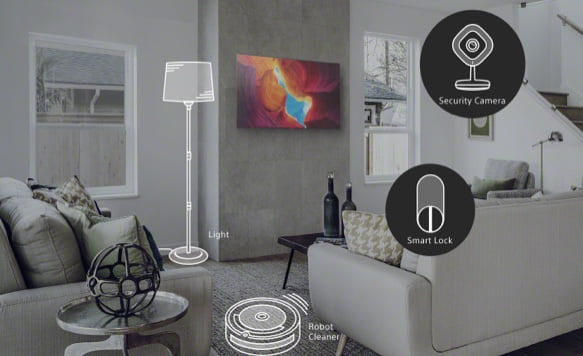
Final Thoughts
The Sony A80K is another solid entry in Sony’s 2022 lineup. To be honest there is not much difference between the A80K and the A80J and each one has its own strengths and weaknesses. Overall the A80K seemed to have better colors but the A80J is more bright. In all other areas their differences are so small it is not worth mentioning.
The A80K’s main strengths were the excellent 4K upscaling, amazing colors, mesmerizing blacks and infinite contrast, good out of the box performance, solid motion, nice viewing angles, low input lag and a Google TV that is fully packed with features.
On the downsides the two HDMI 2.1 ports are surely limiting your options and Sony is behind the competition here as both Samsung and LG offer four similar ports in their releases. Also SDR and HDR brightness is surely lower than expected and we were hoping for something better than last year.
Sony seems to have a lot of faith in the A80K because if the A95K is a bit too much for your budget then the A80K is your next logical option as the A90K comes only in 42″ and 50″ sizes this year. The TV is a good performer as all OLED TVs are and its true blacks are a marvel to look at. Yes, it may not be the best OLED we have seen overall but for the price asked it will make you a happy owner if you seek some OLED magic.
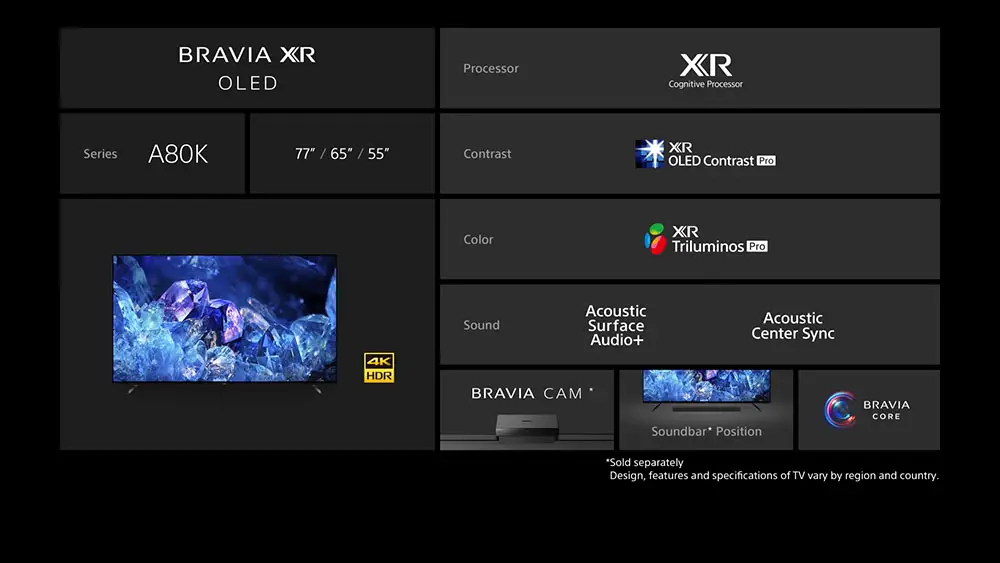
For more reviews you can check our dedicated 4K OLED TV reviews list or even look at our Product Reviews Table where you can find the brand and specific product you are looking for.
Cheapest Places to Buy :
*We are a reader-supported website. When you buy through links on our site, we may earn a small affiliate commission at no extra cost to you. Home Media Entertainment does not accept money for reviews.*
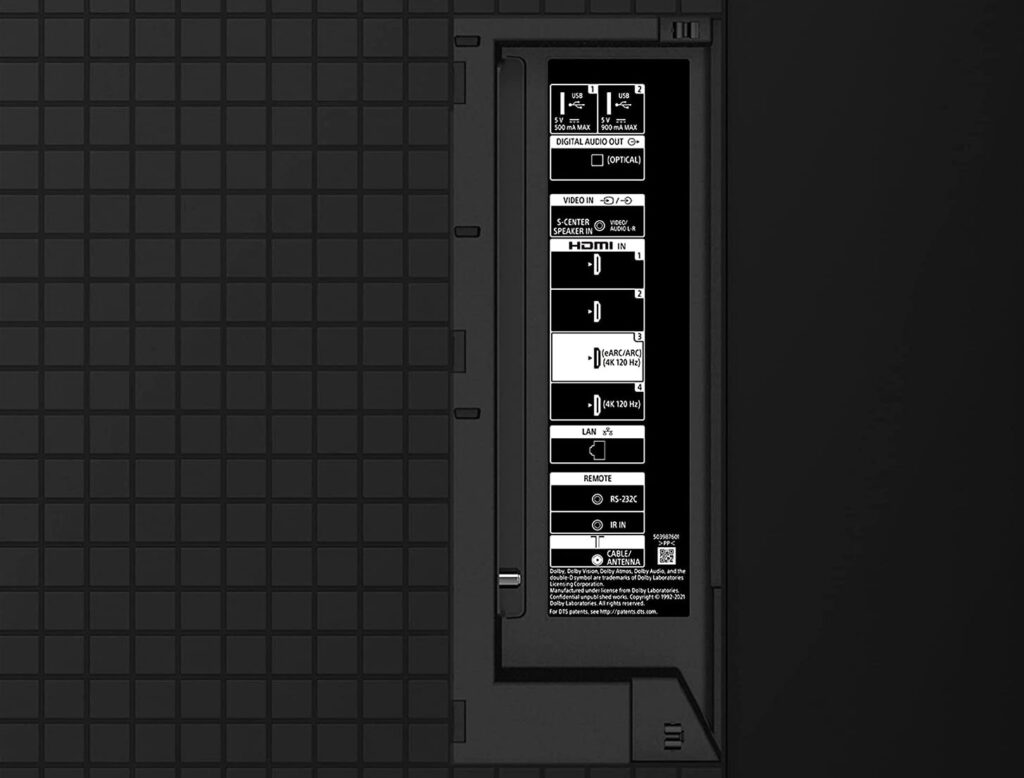
Hey Stratos. The Sony A80K sounds like a bargain buy for the out of the box quality you pay for. The limit of 2 HDMI ports isn’t necessarily a deal breaker but I can see how it might be limiting. I have a Samsung 50″ smart tv that I bought back in 2017 ha-ha and yeah, it’s time for an upgrade. I just hope the burn in isn’t too bad because sometimes I leave my tv paused for an unexpected period of time. All the cons that you mention aside it it seems that the A80K or the A80J could be what I need.
Hey Wes. I would be careful about leaving the TV paused for long hours because this exactly is the main reason burn-in is happening. At least try to turn it off or use a screensaver that can save you from a lot of trouble.
I was really waiting to rad some reviews on this one as I didn’t know if it would be better than the A80J or not. They seem pretty close so at least I know I can buy the cheaper one I can get and not loose anything in terms of image quality.
Indeed Daniel. Get the one you can find in a better price. They are really close in performance so you don’t loose much no matter what you choose.
Some Sony fans are losing their minds over the slightly lower peak brightness compared to last year’s A80J model which your test and several other tests have measured.
We all know the brightness limitations of OLEDS. Yet what does this minor difference in the A80K/A80J nits numbers mean for the actual viewing experience? Nothing as far as I can see. I’ve had my 65 inch for a month and it’s bright even in a reasonably lit room. UHD and Dolby Vision movies are both excellent. I would have bought an A80J if I could have due to lower end-of-model pricing but there was no stock to be found.
I also see that several side by side comparisons by YouTube viewers show the A80K to be slightly brighter. But again, not enough to worry about.
So chill out, kids. This model is still one of the best in class if you are not going for the new generation QD OLEDS from Sony and Samsung.
Couldn’t agree more with you. The perfect blacks of OLED is its saving grace so even some less brightness cannot really affect its overall image quality. Yes, the numbers may show some differences but in real world situations this difference does not have such a big impact as the numbers may suggest. This was a hot debate last year with the A90J and if it was worth to pay the extra premium to get just slightly better performance over the A80J. Obviously if you have the budget and you want the absolute best, then by all means go for it but even the 2nd tier OLEDs offer the kind of performance that is hard for the majority of LED LCDs to have.
Hi. Great review. Do you think on a side by side comparison you would notice much of a difference between a 77 inch a80k versus an 83 inch a90j in overall picture quality across both sdr and 4K streaming? Does the semigloss screen on the a80k versus the gloss screen of the a90j make a difference? I’ve seen the, side by side with a demo loop at a BB and in those circumstances can’t see much but you can’t see that much difference among all the TVs! Is the Lg g2 meaningfully better? Lastly, is the picture quality of the QD a95k enough of a leap to consider, especially moving down in size? Thanks. Regards. Ned.
Hey Ned. As you said the differences are small so it all comes down to what budget you want to spend. The A80K offers an amazing experience. After that the differences are smaller but the price gets steeper. And this is the expense for getting the latest and greatest even if the difference is not as huge as someone might expect.
This was the same argument last year between the A80J and the A90J and if the small difference between them could justify the price difference. Personally I have the A90J and to be honest to you compared to my previous 1500 nits Samsung LED LCD TV I had I cannot understand the brightness difference. It’s that good. And for me right now the A90J remains the best deal you can get. It is still a flagship model but you can still find it in better price since it’s a 2021 release. The A95K is amazing but if it is worth the price for this little extra is up to you.
Having owned 3 LG OLED’s and now the LG C2 that I just purchased, I saw the Sony A80K and it was better than the LG C2 overall. Not to say my C2 is inferior, they are both good, but where the Sony shines is in specular highlights such as lamps, lights and head lights on cars that glow as in real life, colors pop more, details standout more. It is a picture where you just watch and feel and no need to check other picture settings as on my LGC2 to see if another setting is better.
My wife said it best, the Sony has picture quality that no other TV we owned had, it just looks right, more real. My LG C2 is going back and my Sony A80K will be delivered and be used in its place. This brightness war means zip in real world viewing when set to natural settings, what does matter is the specular highlights I mentioned and saw that is what we all should be concerned about and not how bright a TV can go in Vivid mode or any mode settings. HDR and Dolby Vision looks better also than the LG C2 where it renders a very dark viewing experience unless you put the TV in the brighter mode which is not how it was intended to be viewed. On the other hand the Sony nails it. I do miss the ability to stretch the screen size for lower SD content as you can in the LG, I wish Sony would allow this option, but it locks you out because it thinks the streaming is over SD or 480P. So you are stuck with the black bars on each side of the screen but I am sure a firmware update could fix this. Overall for normal viewing the Sony is all one would need, and the better quality you feed it, and that would be from Blu-Ray and 4K UHDs, the better it looks, streaming cannot match the quality of discs, same for high-end audio.
Hello Phil. Thank you for your input and personal experience you had on these two TV. As you said both of them are good with each one having its own strengths. Very valuable and much appreciated. Have a very nice day!
I don’t know why no one mentions that sony has removed CI+ module from the TV this year? the strange thing is that in the specs of TV on Sony website the CI+ module is stillbthere! can someone explain the reason for removing this useful feature!?
Hello Masoud. A lot of new TVs come out without the CI module anymore. Although I don’t know the reasoning behind this if I had to guess I would say this is happening because manufacturers are slowly turning into streaming than satellite TV. And obviously to save costs they take out this port. Nowadays most TVs support online streaming one way or another so they are focusing more on that. But as I said, this is my educated guess from what I see.